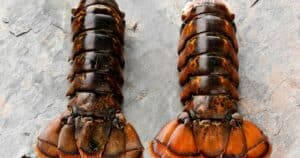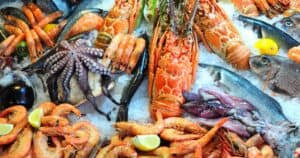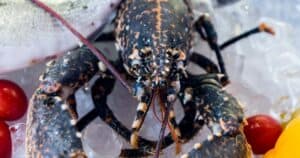Are you tired of chewy lobster meat ruining your dining experience? Discover the facts and secrets to ensuring perfectly cooked lobster every time.
Overcooked lobsters can become tough and chewy, losing their freshness and flavor. But worry not, as we will explore techniques to avoid this common pitfall.
Lobster meat should not be chewy. It should be firm like shrimp but less soft, and definitely not stringy or rubbery. Cooking lobster to the appropriate temperature is crucial to achieving the desired texture and flavor.
To avoid overcooking, using a meat thermometer is highly recommended. Additionally, excessive salt in the cooking water can also affect the natural sweetness of the meat.
In the following sections, we will delve into the step-by-step process of perfectly cooking lobster. We will discuss the ideal cooking temperature, duration, and methods to retain the natural tenderness and juiciness of the meat.
The Importance of Cooking Time and Temperature
Cooking time and temperature are vital factors in ensuring food safety and delicious taste. It’s crucial to understand that the temperature of the food itself, not the cooking environment, is what really matters. Here are some important points to remember:
- Temperature is key: Cooking food to a specific temperature is essential for killing harmful bacteria, especially in meat and other foods. This helps to prevent foodborne illnesses and ensures that the food is safe to eat. Remember, it’s the internal temperature of the food that matters.
- Different foods, different temperatures: Not all foods require the same cooking temperature. Some need to be cooked at lower temperatures while others require higher temperatures. It’s important to know the ideal temperature range for each type of food to achieve the best results.
- The danger zone: The danger zone for bacterial growth in food is between 40 to 140 degrees Fahrenheit. Bacteria can multiply rapidly within this temperature range, risking food contamination. It is crucial to avoid leaving food at this temperature for an extended period.
- Rest time for meats: Resting time is essential for certain meats as it allows the internal parts and juices to cook fully and safely. Always refer to safe minimum internal temperature guidelines provided by trusted sources such as the USDA to ensure proper cooking and prevent foodborne illnesses.
The Role of Salt in Lobster Meat Texture
Salt plays a crucial role in the texture of lobster meat. The cool temperatures in Maine prevent salt water from permeating the meat, resulting in a firmer and more succulent texture. Salting meat, in general, improves the texture and flavor of various types of meat, including lobster.
When salt is applied to raw meat, it draws out the juices from within, forming a brine that is eventually reabsorbed by the meat. This process helps proteins to retain their natural juices, making the meat juicier and more tender.
However, despite the positive effects of salt, there are instances where lobster meat can end up with a soft and mushy texture. This is often seen when the lobster flesh comes out of the shell. Freezing, thawing, and refreezing the meat may contribute to its mushy texture.
Additionally, if the lobster was recently dead or almost dead, enzymes released during the decomposition process can also affect the texture of the meat.
To avoid ending up with mushy lobster meat, it is recommended to buy lobsters alive or as close to capture as possible. This ensures that the meat remains fresh and retains its desired texture.
Visual and Textural Cues for Properly Cooked Lobster Meat
Cooking lobster can be a delicate process, and it’s important to ensure that the meat is cooked to perfection. Visual and textural cues can help determine if the lobster meat is properly cooked. Here are some key indicators to look out for:
Visual cues:
- The shell of a cooked lobster should be bright red all over. This vibrant color indicates that the lobster has been cooked thoroughly and is ready to be enjoyed.
- Cooked lobster meat looks white, with the pink colors closest to the shell becoming a deep red. This color change is a reliable sign that the meat has been cooked properly.
- Pink lines will appear on the outer lobster meat that is closest to the shell. These lines are another visual cue that the lobster meat is cooked to perfection.
Textural cues:
- The flesh of properly cooked lobster should be opaque and pearly white. This opaque appearance indicates that the meat has been cooked all the way through.
- The meat should have a firm and slightly dry texture. It should not be chewy or rubbery, as this can be a sign of undercooking or overcooking.
- The meat should also not be mushy or soft, which could indicate overcooking. Instead, it should have a coarse texture to the touch, with no hint of slime or wetness.
To ensure the lobster meat is cooked to the right temperature, an instant-read thermometer can be used. The internal temperature of properly cooked lobster should read between 135-140 degrees Fahrenheit. This temperature ensures that the meat is fully cooked and safe to eat.
Techniques for Salvaging Overcooked Lobster Meat
Overcooked lobster meat can be disappointing, but fear not! There are a few techniques you can try to salvage it and bring it back to a delicious state. Here are three methods you can use:
Steaming with Boiling Water or Oven:
- Steam the overcooked lobster meat by placing it in a steamer basket over boiling water. This will help to rehydrate the dry meat and make it softer.
- Another option is to wrap the lobster meat in aluminum foil and heat it in the oven with some butter. The heat will melt the butter, adding moisture to the meat and giving it a delicious melted butter flavor.
Reheating in Boiling Water, Steamer, or Oven:
- If the overcooked lobster meat is still salvageable, you can try putting it back in boiling water, a steamer, or wrapping it in foil and placing it in the oven for a minute or two at a time until it is heated through.
- It’s important to keep a close eye on the lobster while reheating to prevent it from overcooking further.
Using in Recipes:
- If the texture of the overcooked lobster meat is too chewy or dry to enjoy on its own, you can try removing the meat from the shell and using it in a recipe that calls for cooked lobster meat.
- Adding the overcooked lobster meat to dishes like pasta, salads, or seafood bisques can help mask any overcooking and make it more enjoyable.
Remember, when reheating cooked lobster meat, it’s essential to use a digital meat thermometer to ensure it reaches a safe internal temperature of at least 140 degrees Fahrenheit. This will help prevent any foodborne illnesses.
So don’t despair if you’ve accidentally overcooked your lobster meat. By using these techniques, you can salvage it and still enjoy a delicious seafood experience. Happy cooking!





